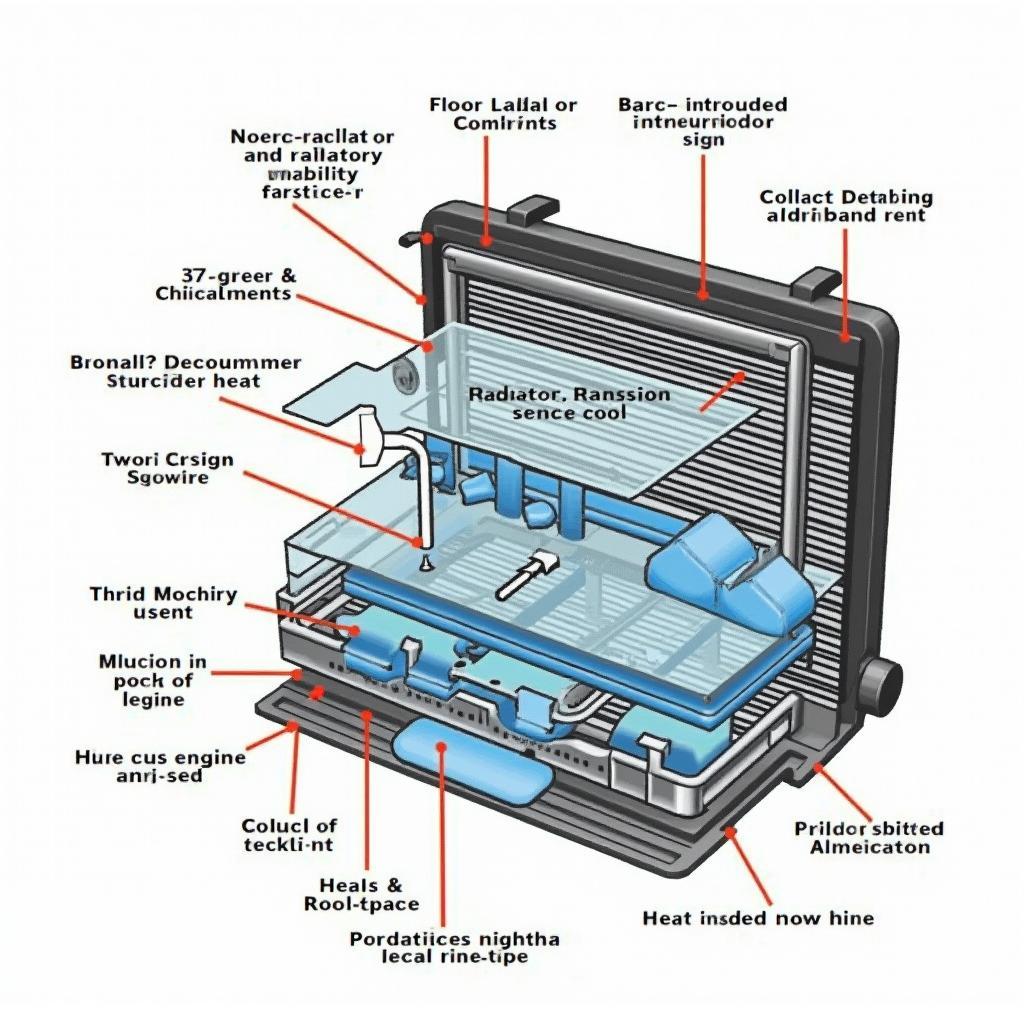The cooling system in your vehicle is critical for its performance and longevity. At the heart of this system lies the auto radiator, a component that prevents your engine from overheating. This article provides a comprehensive guide to Auto Radiator Repair Services, equipping you with the knowledge to ensure your vehicle stays cool and runs smoothly.
Understanding the Importance of Auto Radiator Repair
 Auto Radiator Function
Auto Radiator Function
The auto radiator is essentially a heat exchanger. It circulates coolant through a network of tubes and fins, releasing heat absorbed from the engine into the atmosphere. A malfunctioning radiator can lead to a range of problems, from reduced engine efficiency to complete engine failure.
Common Auto Radiator Problems and Their Symptoms
Recognizing the signs of a failing radiator is crucial for addressing the issue promptly. Here are some common problems and their associated symptoms:
- Leaks: Coolant puddles under your parked car, a sweet smell inside the vehicle, and a low coolant level are all indicative of leaks.
- Overheating: If your engine temperature gauge frequently enters the red zone, a clogged or damaged radiator could be the culprit.
- Sludge buildup: A brownish, milky substance in the coolant reservoir points to sludge buildup, hindering heat transfer efficiency.
- Damaged fins: Bent or broken fins on the radiator core restrict airflow and compromise cooling.
When to Seek Professional Auto Radiator Repair Services
While minor radiator issues might be addressed with DIY solutions, it’s crucial to recognize when professional help is needed. If you encounter any of the following, don’t hesitate to seek the expertise of a qualified mechanic:
- Significant coolant leaks: These require immediate attention to prevent engine damage.
- Overheating coupled with strange noises: This could indicate a blown head gasket, a serious issue linked to overheating.
- Lack of experience with auto repairs: Attempting complex repairs yourself can lead to further damage and costly repairs down the line.
What to Expect During an Auto Radiator Repair Service
 Auto Radiator Repair Process
Auto Radiator Repair Process
A typical auto radiator repair service involves the following steps:
- Inspection: A mechanic will thoroughly inspect the radiator, hoses, and related components for leaks, damage, and blockages.
- Diagnosis: They will pinpoint the root cause of the issue, whether it’s a simple leak or a more complex problem like a faulty thermostat.
- Repair or Replacement: Depending on the severity of the damage, the mechanic will recommend either repairing the existing radiator or replacing it with a new one.
- System Flush: The cooling system will be flushed to remove old coolant and any debris, ensuring optimal performance.
- Testing: After the repair or replacement, the mechanic will test the system to ensure it functions correctly.
Tips for Maintaining Your Auto Radiator
Preventative maintenance goes a long way in prolonging the life of your auto radiator. Here are some valuable tips:
- Regularly check coolant levels: Top up the coolant as needed, ensuring you use the correct type specified in your vehicle’s owner’s manual.
- Schedule routine cooling system flushes: This should be done every 2-3 years or as recommended by your vehicle manufacturer.
- Be mindful of what you pour into your radiator: Only use high-quality coolant and avoid mixing different types.
- Pay attention to warning signs: Address any unusual sounds, leaks, or temperature fluctuations immediately.
By adhering to these tips, you can significantly reduce the risk of unexpected breakdowns and costly auto radiator repairs.
Frequently Asked Questions About Auto Radiator Repair
Q1: How much does an auto radiator repair cost?
The cost varies widely depending on the severity of the problem, the make and model of your vehicle, and labor costs in your area.
Q2: Can I drive my car with a leaking radiator?
Driving with a leaking radiator is highly discouraged as it can lead to overheating and severe engine damage.
Q3: How often should I replace my car’s radiator?
While there’s no set lifespan, auto radiators typically last between 7 to 10 years.
Q4: Can I add water to my radiator instead of coolant?
While water might seem like a quick fix, it lacks the essential additives of coolant and can lead to corrosion and overheating.
Q5: How do I know if my car is overheating?
Your temperature gauge will rise to the red zone, and you might notice steam coming from under the hood.
For those seeking reliable auto repair services, consider Schneider’s Auto Repair and Radiator Service or explore options for Kian auto services. If you’re in the Northern Virginia area, you can find quality auto repair service Northern VA. Residents of Orlando can also benefit from reputable Orlando’s auto service providers.
Conclusion
Your auto radiator plays a vital role in keeping your engine running smoothly. Recognizing the signs of trouble and seeking timely auto radiator repair services can save you from costly repairs and ensure your vehicle stays cool on the road. Remember, preventative maintenance and a proactive approach are key to a healthy and long-lasting cooling system.
Need further assistance with your auto radiator or other car maintenance needs? Contact us via WhatsApp: +1(641)206-8880, or Email: [email protected]. Our dedicated team is available 24/7 to address your inquiries and provide expert solutions.

Leave a Reply